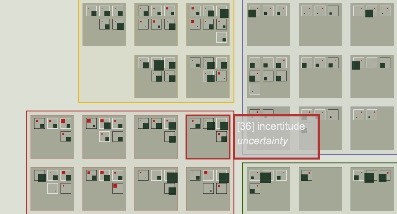

|
The result of the session (48 voters, 86 terms, 250 definitions, 2562 votes) is shown though a visualisation that is somewhat loosely inspired both by Jazwinski's "franco-polish
method" (XIXth century mnemonic method) and by F.Viegas and al.'s "Post history" (contemporary email history viz). A first-level reading is composed of a grid of grids where only the collection of terms is available, including definitions in both languages, so as to weigh the collection itself (number of terms per category, number of definitions for each term in each langage). Two interactive focus views are interactively available where actual votes are shown : - globally, as an overlay of the terms grid, so as to emphasize areas of agreement and areas of disagreement (higher for the "uncertainty" category), - term by term, with here each definition and each voter being shown, so as to fine tune observations, notably by introducing the disciplinary bakground of voters. (SVG , tested on Internet Explorer and Firefox, opens in new window) |

|